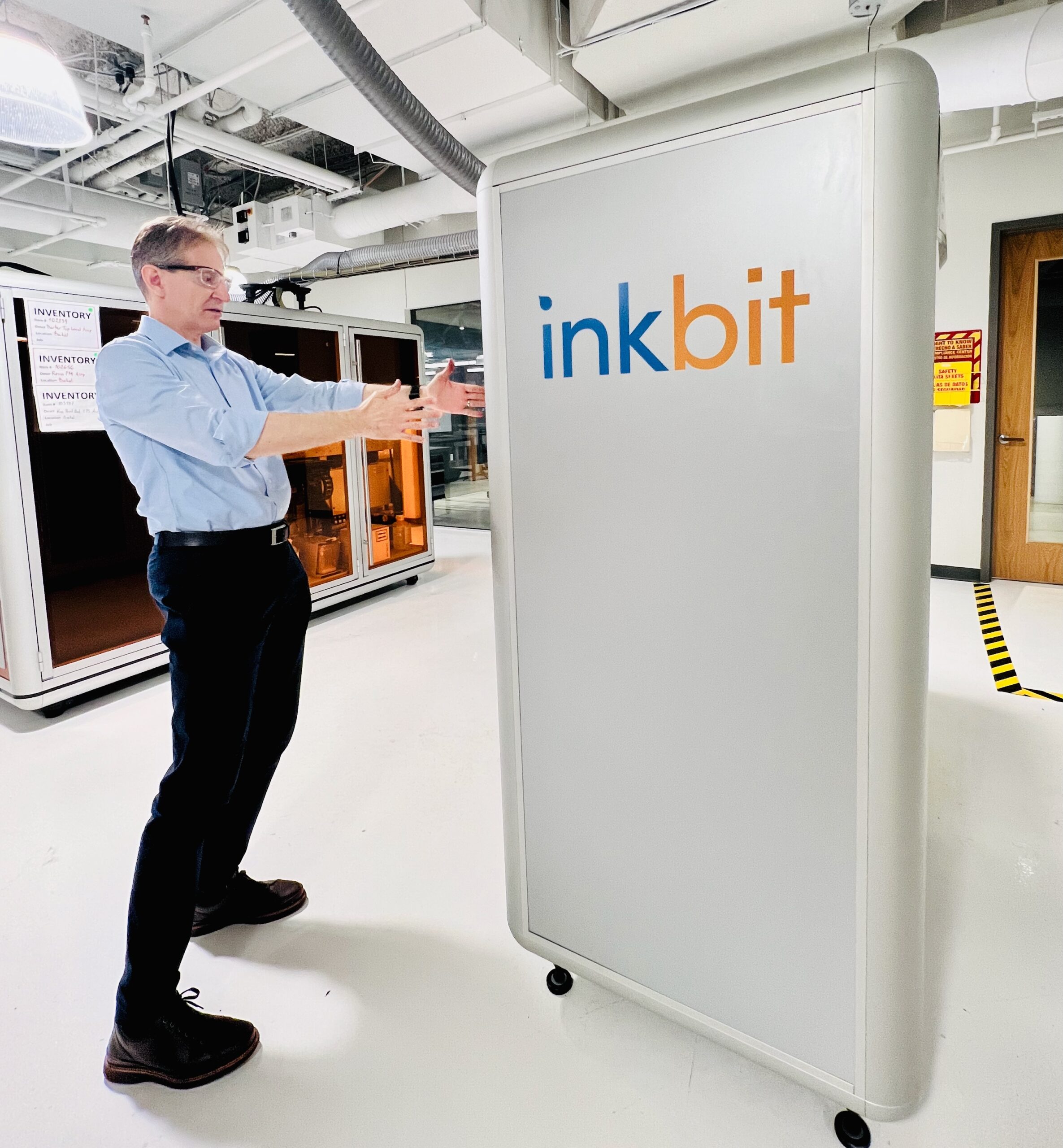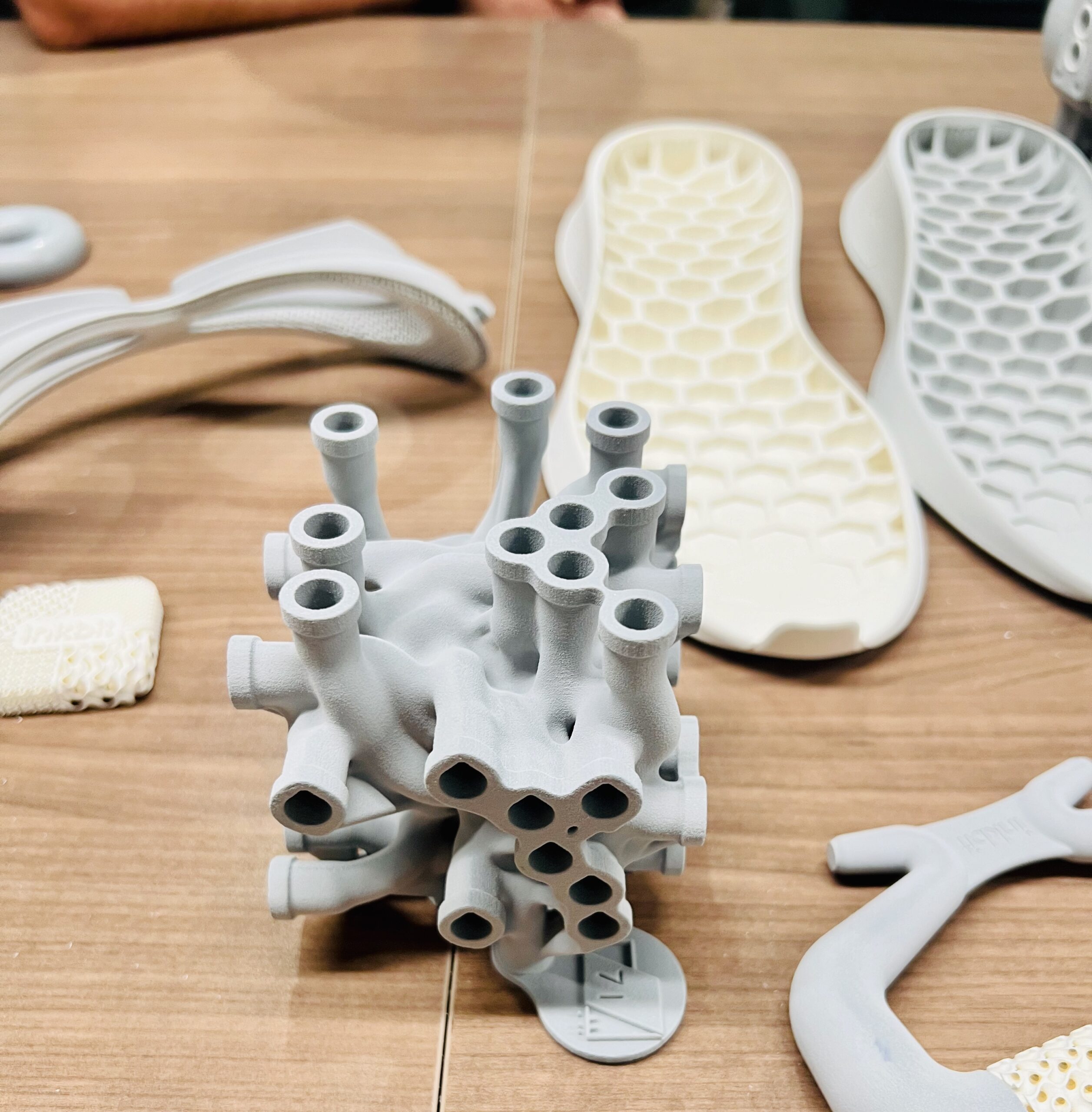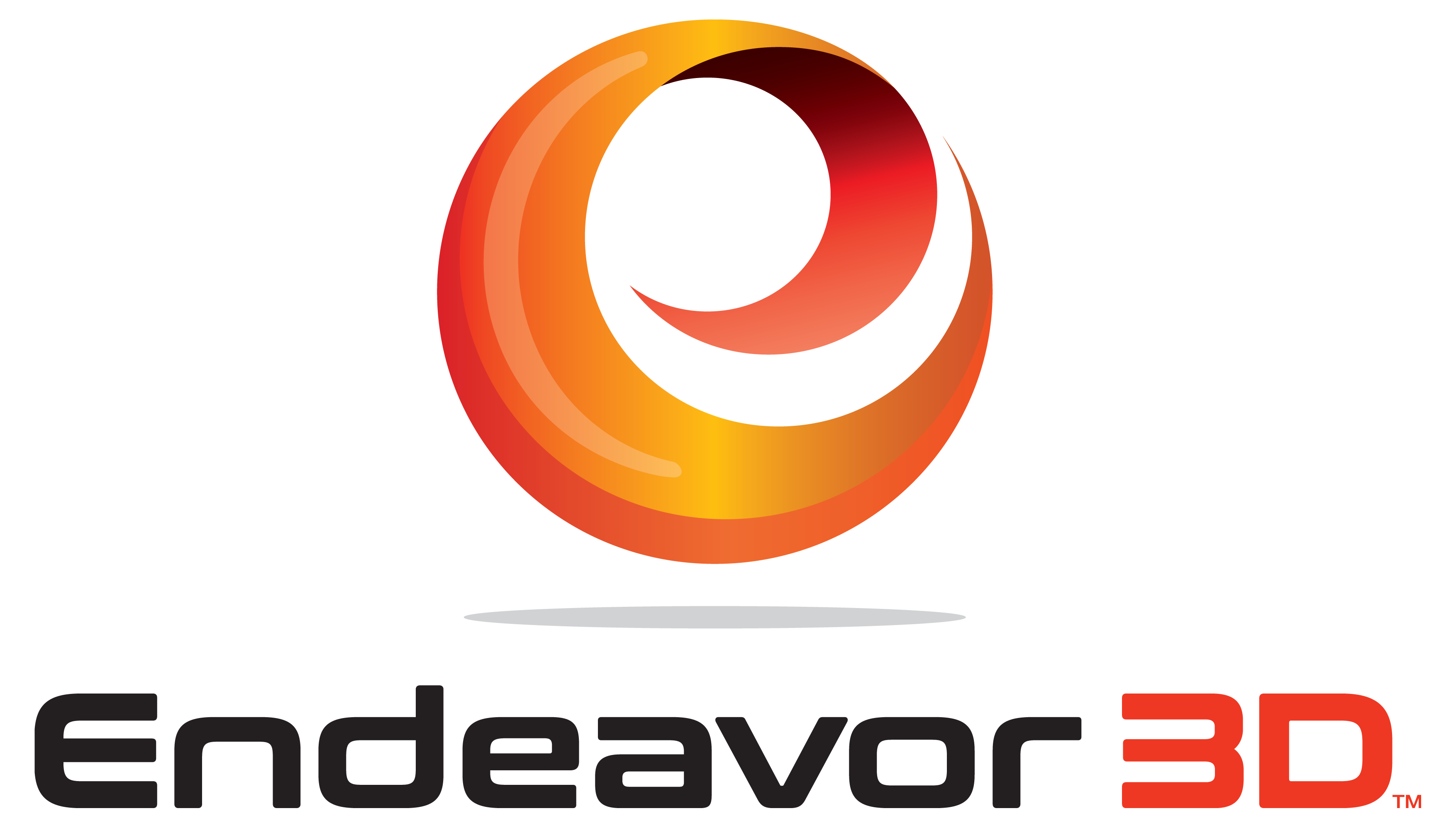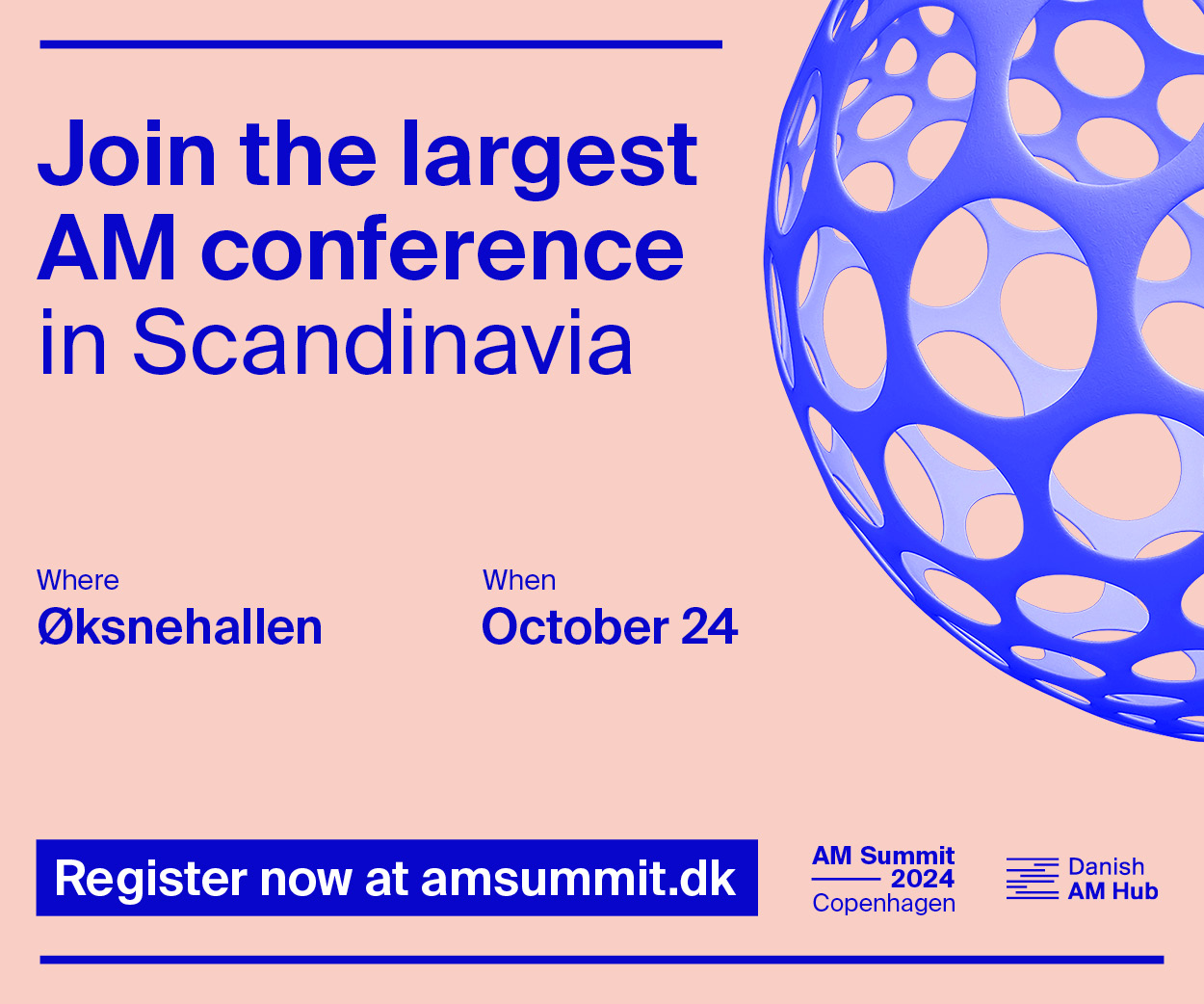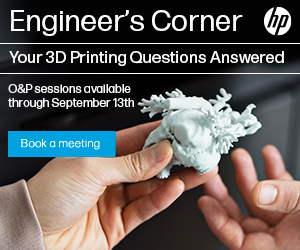At the heart of Inkbit’s innovation is a 3D printer that does more than print—it learns and perfects, creating intricate multi-material parts in a single, streamlined process. This vision-controlled technology, described by CEO Davide Marini as “a machine with a set of eyes,” is setting new standards for industries ranging from robotics to medical devices.
During my visit to Inkbit’s headquarters in Medford, Massachusetts, Marini and co-founder Javier Ramos shared how their innovation drives new possibilities in many applications that rely on additive manufacturing (AM). By merging machine vision with advanced materials science, Inkbit helps industries create products that were previously unimaginable.
Inkbit’s origins trace back to MIT, where Ramos, then a graduate student, began a project that fused machine vision with inkjet printing—a combination that would later become the backbone of Inkbit’s technology. This system continuously scans each layer in real-time to ensure every detail aligns with the design file.
Ramos described the technology’s evolution: “We wanted to create a machine that not only printed but also understood what it was building. This approach allows us to achieve levels of precision that were previously out of reach in additive manufacturing.”
But precision isn’t the only advantage of this system. The real breakthrough lies in its ability to adapt and correct on the fly, making it possible to work with new materials and geometries that traditional methods simply couldn’t handle.
Chemistry Breakthrough
“Initially, our goal was to make a more reliable and precise machine,” pointed out Marini. “But along the way, we discovered that our contactless process enabled entirely new chemistries. This has become the key differentiator for Inkbit. Our system eliminates the need for mechanical flattening, which means we can print complex structures without the constraints imposed by contact-based methods. This innovation opens the door to creating multi-material parts with intricate details, all in a single, streamlined process.”
As Marini points out, one of the core innovations of Inkbit’s technology is the elimination of mechanical flattening—a process in traditional 3D printing where each printed layer is pressed down to ensure smoothness and accuracy. While effective, this method limits the materials and structures that can be used because the material needs to withstand the pressure. By eliminating this step, Inkbit’s system achieves contactless printing. Instead of pressing down on each layer, the printer uses its vision-controlled process that scans and adjusts the print in real-time, allowing for a wider variety of materials, including those too soft or delicate for traditional methods.
This system also enables the integration of external components, such as metal or electronics, into the printed parts.
“We can easily have the plate move under a pick-and-place robot that can place a piece of electronics, and then the scanner will see that and print around it,” says Marini.
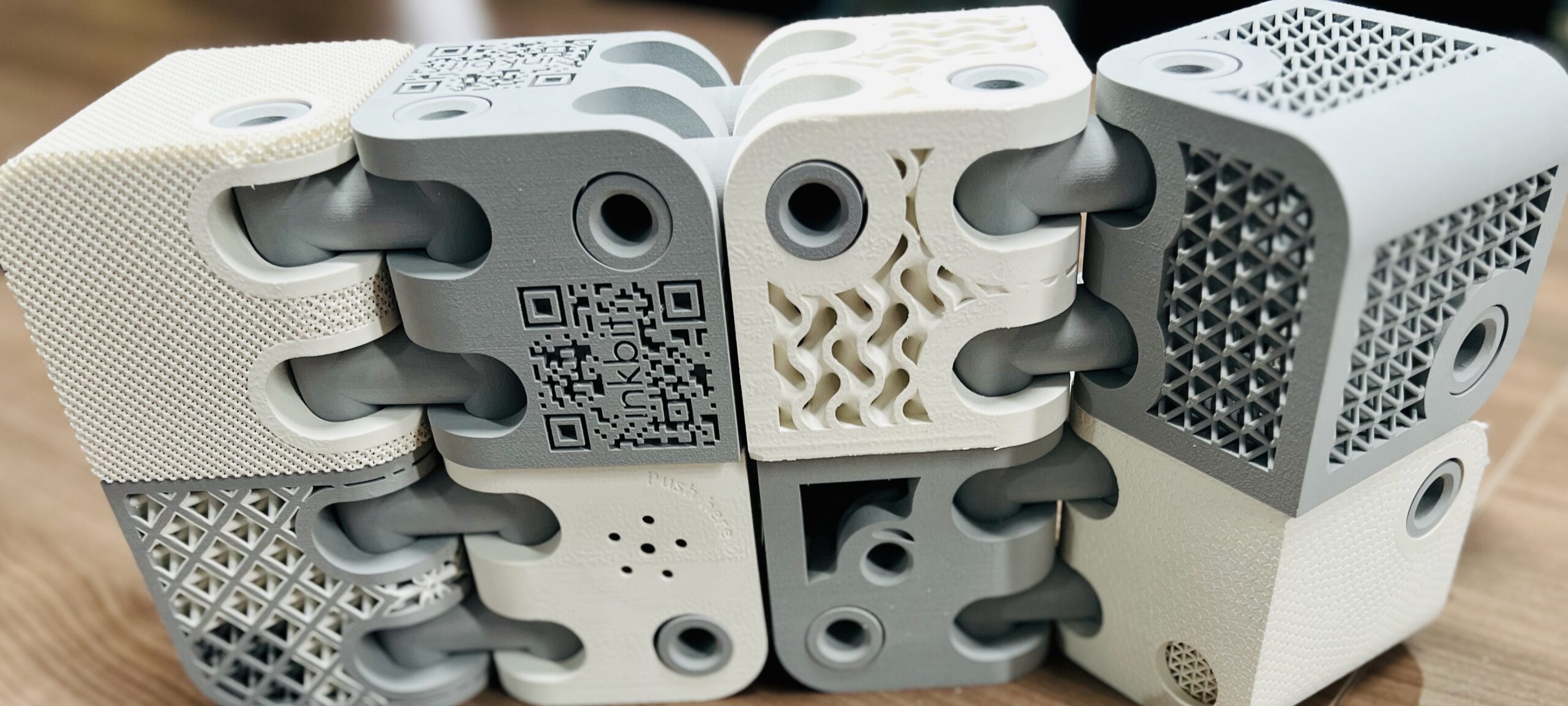
This eight-square part showcases Inkbit’s ability to produce multiple textures and material properties in a single print.
The products this machine can create are best understood by experiencing them firsthand. Among the various samples Inkbit had on display, one part stood out: a small piece featuring eight distinct textures and feels, all created in a single print. While one square was completely squishable, another was solid and hard. In between, the other squares offered a range of firmness but transitioned from hard to soft and flexible.
These differences show just how many things this technology could be used for. The range of materials opens up so many possibilities. For example, flexible and rigid materials in a single product could be ideal for wearable technology or custom prosthetics and orthotics. Creating robotic components that require different degrees of flexibility and rigidity within a single part could lead to more lifelike, adaptive robots.
Other industries that might benefit from this include automotive, where parts such as seals or gaskets could be produced more efficiently. In the consumer goods segment, everything from ergonomic grips on tools and gadgets to custom-fit footwear could be well-tailored.
Material Innovation
While the technology itself is groundbreaking, Inkbit’s true edge lies in its innovative approach to materials. Marini, whose passion for material sciences can be traced back to his time spent at both Politecnico di Milano and MIT, where he earned his PhD in Mechanical Engineering, explains that Inkbit’s founders have developed new chemistries that expand the range of printable materials, opening doors to broader applications.
Inkbit’s technology requires highly specialized materials due to the complexity of inkjet printing. Developing these materials is challenging because they must have low viscosity to be jetted through tiny nozzles at high speeds. Unlike other 3D printing methods that can adapt existing materials from other industries, Inkbit has to create new chemistries from scratch. This has made finding partners in material development difficult, as many companies prefer working with more established processes. However, Inkbit sees this challenge as an opportunity for innovation, with about a third of its team dedicated to chemistry.
The ability to print multiple materials simultaneously, including both soft and rigid parts, without requiring assembly is one of the biggest selling points for Inkbit. This capability, paired with the continuous development of new materials, is a major innovation, especially in an industry like 3D printing, where materials have been the number one challenge.
Despite the many advances, the team knows the challenges, particularly in material development: “Developing materials is very painful,” Marini admitted. “It’s hard because you need to start from scratch. This process is not only time-consuming but also resource-intensive. For this reason, Inkbit often works with industry leaders to develop materials that meet specific application needs. These collaborations are essential for our company,” says Marini.
Applications and Partnerships
Inkbit’s strategic partnerships span various industries, including dental, robotics, and consumer products, and the company is also exploring opportunities in the fashion industry. Additionally, Inkbit’s technology excels at creating long, intricate channel structures within parts, a capability particularly valuable in fluidics applications and potentially useful in semiconductor cooling systems.
Inkbit is now focused on developing better materials tailored to specific applications, such as shoes and manifolds, where customers have unique requirements. This work also shapes their approach to hardware and software as the company increasingly collaborates with clients to meet specific industry needs.
While Inkbit’s technology is undoubtedly advanced, the company’s approach to artificial intelligence (AI) also stands out. AI is key in calibrating the printing process for maximum accuracy and precision.
“One of the beautiful things about our scanner is that it generates a lot of data every build,” explained Ramos. “We use AI to calibrate the machine for maximum accuracy and precision. This continuous calibration ensures that the machine delivers consistent, high-quality results with every print.”
Industry Challenges
However, like many others in the 3D printing industry, Inkbit faces some hurdles. “It’s a tough time for 3D printing; there’s not a lot of growth,” Marini acknowledged. “While 3D printing has the potential to revolutionize many industries, it’s not feasible for any single company to be an expert in all these fields. I think the biggest challenge that we face is that 3D printing has the allure of enabling everything. But it’s just impossible to be an expert in all those fields.”
Looking ahead, Inkbit focuses on deepening its expertise in specific applications rather than spreading itself too thin across multiple industries. This targeted approach will likely be the key to success in a highly competitive and rapidly evolving market.
“My gut feeling says that the solution will come from doubling down and deepening the focus on fewer application fields for each company,” Marini concluded.
Inkbit holds around 34 patents, covering innovations in hardware, print processes, materials, and software. While some of their IP came from MIT, most were developed by Inkbit. With the core printing process and hardware in place, the company’s focus has shifted toward advancing materials and applications, with Inkbit’s success in finding the right applications for their technology. This is why they work closely with industry leaders through strategic partnerships to develop the best applications for the technology. The search for these perfectly matched collaborations is essential to Inkbit’s refining of its hardware and software to meet industry demands.
All images courtesy of 3DPrint.com.
Subscribe to Our Email Newsletter
Stay up-to-date on all the latest news from the 3D printing industry and receive information and offers from third party vendors.
You May Also Like
3D Printing News Briefs, September 15, 2024: Crowdfunding, EVs, Microalgae, & More
Good news for Fishy Filaments, which has reached a major funding milestone! This kicks off our business news in today’s 3D Printing News Briefs, followed by Voxel Innovations relocating its...
3D Printing Webinar and Event Roundup: September 14, 2024
In this week’s roundup, Divide By Zero Technologies is having a launch event for its new 3D printer tomorrow. Stratasys continues its tour of North America, as well as its...
US Justice Department and ATF Push to Stop 3D Printed Machine Gun Switches
For years, the spotlight on 3D printing’s potential for firearm production has revolved around fully 3D printed guns. However, the attention has now shifted to a far smaller, cheaper, and...
3D Printing Webinar and Event Roundup: September 8, 2024
In this month’s first 3D Printing Webinar and Event Roundup, things are picking up! There are multiple in-person events this week, including the TETS Symposium, Additive Manufacturing in Medicine, a...


